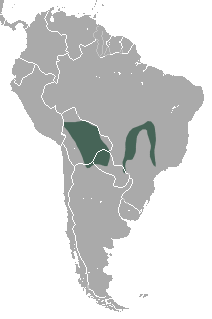| Pygmy short-tailed opossum[1] | |
|---|---|
| Scientific classification | |
| Domain: | Eukaryota |
| Kingdom: | Animalia |
| Phylum: | Chordata |
| Class: | Mammalia |
| Infraclass: | Marsupialia |
| Order: | Didelphimorphia |
| Family: | Didelphidae |
| Genus: | Monodelphis |
| Species: | M. kunsi
|
| Binomial name | |
| Monodelphis kunsi Pine, 1975
| |

| |
| Pygmy short-tailed opossum range | |
The pygmy short-tailed opossum, (Monodelphis kunsi), is an opossum species from South America. M. kunsi is a marsupial from the family Didelphidae of the order Didelphimorphia. Although it is a marsupial, it lacks the characteristic pouch that is often associated with this order.[3] It is found in Argentina, Bolivia, Brazil and Paraguay. M. kunsi is considered a smaller species within the family Didelphidae, which is why it is named a pygmy opossum.[4] The young are referred to as 'joeys'. The females are referred to as 'Jill,' and the males 'jack'. It was thought to have been endangered in 2001, but has since been moved to least concern by the International Union for Conservation of Nature.[5]
- ^ Gardner, A. (2005). Wilson, D.E.; Reeder, D.M. (eds.). Mammal Species of the World: A Taxonomic and Geographic Reference (3rd ed.). Johns Hopkins University Press. p. 15. ISBN 978-0-8018-8221-0. OCLC 62265494.
- ^ Solari, S.; Vilela, J.; Tarifa, T. (2015). "Monodelphis kunsi". IUCN Red List of Threatened Species. 2015: e.T13696A22170540. doi:10.2305/IUCN.UK.2015-4.RLTS.T13696A22170540.en. Retrieved 12 November 2021.
- ^ Hannibal, Wellington, Vlaquiria V. Figueiredo, Paulo Landgref Filho, and Mauricio N. Godoi. "New Records of Monodelphis Kunsi (Didelphimorphia, Didelphidae) from Brazil." Mastozoología Neotropical 19.2 (2012): 317-20. Web. 10 Nov. 2016.
- ^ Anderson, Sydney. "Monodelphis Kunsi." Mammalian Species 190 (1982): 1. Web.
- ^ Carvalho, B de A., Oliveira, L. F. B., Langguth, A. Freygang, C. C., Ferrax, R. S., Mattevi, M. Phylogenetic relationships and phylogeographic patterns in Monodelphis (Didelphimorphia: Didelphidae). Journal of Mammalogy. 92(1): 121-133. 2011
